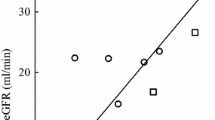Abstract
Purpose: Carboplatin doses can be individualized using the formula of Calvert et al. (Calvert formula) dose (mg) = area under the plasma concentration versus time curve (AUC) · [glomerular filtration rate (GFR) + 25]. Creatinine clearance (Ccr), either measured by the 24-h method or calculated by the formula of Cockcroft and Gault [Cockcroft-Gault (CG) formula], is often substituted for the GFR. The CG formula is based on patient weight, age and sex, and the serum creatinine (Cr) concentration. Another method for predicting carboplatin clearance (CL) using patient characteristics has also been proposed by Chatelut et al. (Chatelut formula). This study was undertaken to evaluate the performance of the three formulae in predicting standard- and low-dose carboplatin pharmacokinetics. Methods: A total of 52 patients with advanced lung cancer were enrolled in this pharmacokinetic study; 37 received standard-dose carboplatin and 25 received low-dose carboplatin. The Cr concentration was measured using an enzymatic assay. The three formulae were used to predict carboplatin CL. The median absolute percent error (MAPE) for each formula was evaluated by comparing the calculated and observed CL. For comparison of AUCs, free platinum plasma concentrations were measured at intervals up to 24 h after carboplatin administration. AUCs were determined and compared with predicted values. Results: In the standard-dose carboplatin group, the MAPEs for the prediction of carboplatin CL from the 24-h Calvert, CG-Calvert and Chatelut formulae were 13%, 12% and 23%, respectively. In the low-dose carboplatin group, the corresponding MAPEs were 27%, 18% and 44%, respectively. Observed standard-dose carboplatin AUCs after aiming for target AUCs of 5 and 6 mg · min/ml using the Calvert formula based upon the 24-h Ccr were 5.3 ± 0.8 and 5.9 ± 0.8, respectively, indicating a small and acceptable bias compared with that predicted from the dosing formula. Conclusions: The pharmacokinetics of standard-dose carboplatin were accurately predicted by the Calvert formula based upon either 24-h or CG-calculated Ccr, but not by the Chatelut formula. Either CG-calculated or 24-h Ccr can be substituted for the GFR in the Calvert formula for the determination of individual doses. The poor predictability of the Chatelut formula found in this study might be the result of a differences in either the Cr assay or the patient population. Therefore, formulae which attempt to estimate GFR are not necessarily valid if either the Cr assay or the patient population is changed.
Similar content being viewed by others
Author information
Authors and Affiliations
Additional information
Received: 23 July 1997 / Accepted: 16 December 1997
Rights and permissions
About this article
Cite this article
Okamoto, H., Nagatomo, A., Kunitoh, H. et al. Prediction of carboplatin clearance calculated by patient characteristics or 24-hour creatinine clearance: a comparison of the performance of three formulae. Cancer Chemother Pharmacol 42, 307–312 (1998). https://doi.org/10.1007/s002800050822
Issue Date:
DOI: https://doi.org/10.1007/s002800050822




